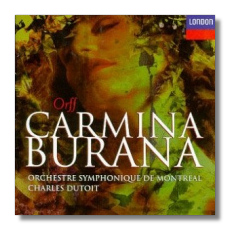
The Internet's Premier Classical Music Source
Related Links
- Orff Reviews
- Latest Reviews
- More Reviews
-
By Composer
-
Collections
DVD & Blu-ray
Books
Concert Reviews
Articles/Interviews
Software
Audio
Search Amazon
Recommended Links
Site News
 CD Review
CD Review
Carl Orff

Carmina Burana
Beverly Hoch, soprano
Stanford Olsen, tenor
Mark Oswald, baritone
Montréal Symphony Orchestra/Charles Dutoit
London 455290-2
Let me say at the outset, I just plain enjoyed listening to this recording. I will admit there are currently only two other recordings in my library. The one by Stokowski is counted out due to a poor transfer by EMI and singing that at times sounds 'southern U.S.A.'. This is particularly evident in the crooning in "Shopkeeper, give me some colour". (Then, too, maybe this was Stokowski's idea of an inside joke.) My favorite has been Slatkin's recent RCA recording (9026-61673). While I still like that one, this one by Dutoit is just pure pleasure to listen to. The two performances are damn near identical in timings and here is evidence that timings are often of no help in describing a performance. Relief (as Stokowski put it) or balance, phrasing are factors which are primary in differentiating these two, fine performances.
[Digression: If you really want to hear the 'meaning' of different phrasing try this. Listen to the opening of Bach's Partita #2 for solo violin as played by Perlman. Then listen to anyone else. If that doesn't offer an operational definition (and that is the only kind of meaningful definition such concepts can have) then you just don't get it.]
Compare the difference in relief in "O Fortuna" as but one example. After the haunting, pianissimo play, Slatkin has the percussion more forward, woodwinds recessed. Dutoit reverses the balance. The result is that Slatkin's recording is more barbaric, Dutoit is more mysterious. I think this music is open to both interpretations and appreciate each for its own strengths. Ultimately, however, I find the Dutoit balance and phrasing here more to my liking.
Throughout the Montréal recording the whole crew seems to be having a good time. It is like everyone is on the same track (pun intended). I can visualize them smiling as they play and sing. Listen to the bounce in the singing in track 5! If that ain't music to welcome Spring, I don't know what is. The flute work in track 6 "Dance" is an absolute delight. The music is ethereal where it should be. I cite as one example the lovely soprano singing in track 7 "The noble woods are burgeoning".
Let me get back to the issue of relief for a moment. That term, by the way, was the one Stokowski used in an interview with Dan Rather. He used it as an analogy between sculpture and music. Sorry, another digression. Anyway, generally it is like this: RCA - orchestra and chorus; London - orchestra with chorus. That is, in the former the chorus is subordinate to the orchestra. In the latter they are equal partners. This provides a more natural sense to the sound of things.
Soloists? Well, here the recording balance changes in the RCA recording. Suddenly the soloists are in-your-ears! Great as Sylvia McNair is, and she is, the frontal assault, leaving the orchestra like fog in the background, is a bit unsettling. Beverly Hoch's sound is just fine, thank you, and better integrated into the total picture. As for the men, much the same is the case here. Not in-your-ear, both Stanford Olsen and Mark Oswald on the Dutoit recording have a more 'medieval' phrasing. The Montréal recording is more natural and this adds to its greater sense of involvement.
There are a plethora (I always try to work that word into a review) of magical moments in this recording, and here, again, some might refer to this as phrasing. Listen to the short "Sweetest One" (track 23) As the piece draws to a close, Hoch hands the last note to the orchestra for its echo into silence. This is an example of how this recording is helping me develop a 'musical map' of this piece. It is becoming a reference point for me for future reviews. These 'magical moments' are part of the appreciation of classical music. While I do listen to Dylan still, from time-to-time, (okay, and others from the 60s!!!) it is moments like this one in Carmina Burana that resonate in my ear's mind because of its multiple meanings.
Here's the bottom line. While working on this review I had been switching back-and-forth between the two recordings. A moment ago, while listening to the Slatkin recording, I suddenly realized I wanted to hear Dutoit's instead. So, I got up and am now enjoying it once again. This is a peak musical experience enhanced by superb sonics. I am certain I shall return to it again and again.
PS Oh, yeah. Insert notes. London's has text only, no biographical or musical discussion. RCA's includes a thumb nail discussion of the music which have been appreciated if London had included some, too. But then, we don't buy CDs for insert notes.
PPS If you are new to my 'style' of writing, it suffers from digressions. Kind of like running into an old man on a park bench, but he blathers on about philosophy. Egad.
Copyright © 1997, Robert Stumpf II


















